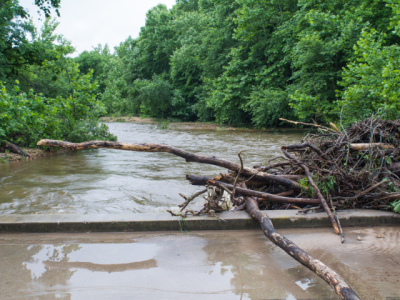
To: Municipal Applicants for FEMA Public Assistance under DR4720 ("severe storms and flooding, July 7-21, 2023").
From: Eric Forand, Director, Vermont Emergency Management
Date: October 12, 2023
At this time, all municipal collection of debris from flooded buildings should be completed. However, you may still have debris in and alongside rivers and streams, including vegetative debris (e.g. trees and branches caught up against bridge abutments), as well as gravel and sediment which are choking the stream channel and creating potential for further flooding of infrastructure during a future storm.
Natural debris left in the river after a flood cannot be removed without notification of and review by the Department of Environmental Conservation (DEC). This includes areas around culverts and bridges. In all cases where you believe there is debris remaining from the storm which poses a problem or threat, we urge you to take the following steps:
- Consult with your Agency of Natural Resources River Engineer. Use this online form to contact your Rivers Management Program or call 802-828-1115. If the River Engineer concurs with your proposed course of action for managing the debris in question, they can assist you in finding a quick application for Municipally Authorized Emergency Protective Measures.
- Notify your FEMA Program Delivery Manager of your intention to undertake additional debris management. Note that the debris management activity must be listed on your Damage Inventory, due to FEMA within 60 days after the date of your Recovery Scoping Meeting. Most DR4720 applicants have Damage Inventory deadlines coming up in late October, with the earliest ones due 10/21/23.
FEMA debris eligibility is based on policy guidance in the FEMA Public Assistance Program and Policy Guide. starting at page 99:
Debris is defined as follows (emphasis added):
"Debris includes, but is not limited to, vegetative debris, construction and demolition debris, sand, mud, silt, gravel, rocks, boulders, white goods, and vehicle and vessel wreckage."
Take note of this language from page 104:
"Debris deposited by the incident may obstruct a natural waterway (that is, a waterway that is not improved or maintained) or a constructed channel, including flood control works. In these cases, removal of the debris from the channel is eligible if the debris poses an immediate threat, such as when the debris:
- Obstructs, or could obstruct, intake structures;
- Could cause damage to structures, such as bridges and culverts; or
- Is causing, or could cause, flooding to improved public or private property during the occurrence of a 5-year flood."
FEMA officials assigned to this disaster have been helpful in working with communities to address riverine debris. Based on the current US Army Corps of Engineers' Nationwide Permit #3, they are generally taking the position that debris within 200 feet upstream or downstream of an eligible structure (such as a bridge or culvert) is considered eligible for removal. Applicants are encouraged to reach out to their FEMA Program Delivery Manager to discuss specific locations, and proper documentation, including locations and photos is essential for FEMA submission. The removal of sediment is limited to the minimum necessary to restore the waterway in the vicinity of the structure to the approximate dimensions that existed when the structure was built, but cannot extend farther than 200 feet in any direction from the structure.
If you see a need to manage debris within stream or river channels, now is the time to confer with your river engineer and report it to FEMA.
The period of performance for FEMA-eligible debris management is 6 months from the start of the incident period (in this case, January 7, 2024), but it can easily be extended for an additional six months by submitting an Extension Request to Vermont Public Assistance Officer Kim Canarecci (kim.canarecci@vermont.gov) with copy to ADM.2023floods@vermont.gov. By requesting an extension, you can maintain the ability to conduct FEMA-eligible debris management operations into spring 2024.
Questions? Reach out via ADM.2023floods@vermont.gov.